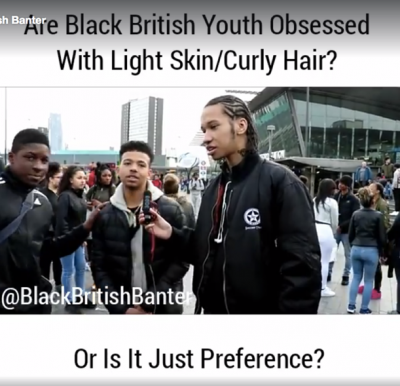 A mere 2 minutes and 19 seconds in length, the video Are Black British Youth Obsessed with Light Skin/Curly Hair. Or is it just Preference?” is a compilation of snippets from “person on the street” interviews, conducted in the environs of two shopping centers and a commuter railway station in east London (more on this later).
A mere 2 minutes and 19 seconds in length, the video Are Black British Youth Obsessed with Light Skin/Curly Hair. Or is it just Preference?” is a compilation of snippets from “person on the street” interviews, conducted in the environs of two shopping centers and a commuter railway station in east London (more on this later).
The interviewer is a roving Internet reporter going by the handle of VanBanter, whose YouTube channel boasts over 85,000 subscribers. VanBanter is a tall, svelte, black Briton of around 16, himself light skinned, whose voluminous hair in the clips is either styled in cornrows, or pulled back in a low Afro puff, the black version of the “man bun.”
The interviewees are black boys, ostensibly between the ages of 12 and 17, of a wide spectrum of skin colors and hair textures. The single question VanBanter asks all of them is, “What kind of girls are you into?” On occasion, he phrases it as, “What type of girls do you slide into?” Two token girls are asked the same question about boys. All interviewed say they like “light skins.” Some add “curly hair,” clearly meant as a qualifier in opposition to “kinky,” not straight, hair texture. Hence, palpably, one can infer that light-skins are more favoured than any other colors at the place. Most of the interviewees are filmed standing in pairs or small groups of friends who support their responses with interjections, gestures, or general glee.
The video was first uploaded on June 1st to the Facebook page of Black British Banter. Over that weekend, it received a million views, over 6k likes (2.6k neutral thumbs-up expressing interest, 1.2k crying emojis, 1.1k angry ones, 546 laughing ones, 467 wows, and 62 loves), 5k comments, and 8,000 shares.
I myself could not stop viewing it. The comments far outstretch the bounds of personal preference, to which we all have an undisputable right. Instead, they defend a centuries-old global regime of negating not only the beauty, but very humanity, of people with dark skin, especially women. “No black t’ings, like my shoes n’ shit!” says one very dark-skinned boy, luminous in red track suit and fresh fade. “Light skins, always light skins, man,” says another boy hubristically, he himself light of complexion. Surprisingly, his mate, a much darker boy, steps forward into the frame of the shot to pat him approvingly on the shoulder, then retreats with a satisfied smirk on his face. “All o’ dem!” responds a third speaker, who looks to be around age twelve. Goaded on by his surrounding posse of friends, the boy continues. “Curly” – which he pronounces “queely” – “hair, light skin, all o’ dem. No dark skins, no dark skins!”
I must have replayed this entire video twenty times or more. Each time, something new shot forth to astonish, inform, infuriate, dismay, perplex, even amuse and impress, but, regrettably, raise little hope in me from the mouths of this Black British youth, minors, all of them.
Impressive is the boy who is the companion of the one who says he keeps his shoes and his women separate. Addressing the camera directly, he lyrically traverses two or more generations and thousands of geographic miles in just one comment. He starts out delivering his reply in a vernacular London tongue, not quite Cockney, but close to it, dropping his t’s and adding the emphatic “yeah” at the end of his sentence: “Light skin, big back, big ti’i, yeah” (“Light skin, big behind, big titties.”). He then deftly code switches to Jamaican-inflected patois, eliding the “nt” in the word “want” with a subtle exhalation, and substituting, as in most Caribbean creole languages, “to” with “for”: “Wah fi tek wood. Dem gyal deh.” (“Want [or, it might be one] to take wood. Those kind of girls.” Wood is penis). All this he delivers with an emcee’s flow, synching his posture and hand gestures to his speech. Beautiful in sound and adept in motion! His is the most performative delivery of a speech pattern that all the youth, the interviewer included, communicate in.
London Multicultural English, or MLE, as it has come to be termed, is a patchwork of vocabulary, syntax, and inflections woven together from a multitude of language families transported to London by regional and international migrants over the course of centuries. In years closest to ours, the dialect’s four decided grandparents are Cockney English, Caribbean creole or patois, languages from former British colonies in, chiefly, the Indian Subcontinent and West Africa, and “learner varieties,” the in-between states of fluency formed during any process of second-language acquisition. If you listen closely to this crowd of youngsters, you’ll hear from the Cockney grandparent a lot of “innit,” “know wha’ ah mean?” and elisions of the double “t” in words like “butter.” From the Caribbean forebear comes the pronunciation of “them” and “that” as “dem” and “dat,” the erasure of the final “g” in gerund words (“cleaning” becomes “cleanin”), and the practice of teeth sucking, a catch-all method of dismissing or objecting to a circumstance or expressed opinion, used throughout the African diaspora, as well as it’s onomatopoeic cousin, the short non-word “Chuh!”, which is more specific to the Anglophone Caribbean. There is also a cousin once-removed, Hip Hop Nation Language, hailing from African America.
When I watch and listen to these kids, I think to myself, thence came Grime music and a host of art forms, past and current, that have infused British popular culture. But, then, the horrifying thoughts crowd in. What are the stakes of social mobility and political inclusion for kids like these whose mother tongue is MLE? Is London, or all of Britain, hurtling towards the same trials and tribulations vis-à-vis the state and public education that the U.S.A. has faced with Ebonics? And, is that deft youth’s flow the spontaneous rehearsal of some other boy’s or man’s rhyme he’s heard elsewhere, maybe on somebody’s Grime track. Worse yet, given its noxious sentiments, is it part of a rhyme scheme he’s producing for mass consumption? Either way, the thoughts he poeticizes can and do travel through popular music, literally becoming soundtracks to these young people’s lives.
My generation inherited and in turn passed down a fair share of those soundtracks. Remember Buju Banton’s “Love me Browning” from 1992? The refrain went, “Me love me car, me love me bike, me love me money and t’ing. But most of all, me love me browning” – his light-skinned girlfriend. The song topped the charts in Jamaica and was appreciated worldwide by enthusiasts of Jamaican dancehall music, which basically means the Jamaican and pan-Caribbean diaspora. I couldn’t help but get an echo of Banton when I heard one of the interviewees say, “I like my light skins.” This is an intergenerational playback loop. In 1994, the Notorious B.I.G., one of the most heroicized martyrs of the U.S. Hip Hop Nation, born Christopher Wallace in 1972 in Brooklyn to Jamaican parents, released the track, “One More Chance,” whose opening rhyme goes as follows,
First things first: I, Poppa, freaks all the honeys
Dummies, Playboy bunnies, those wanting money
Those the ones I like ‘cause they don’t get Nathan, but penetration
Unless it smells like sanitation
Gar-bage, I turn like doorknawbs
Heartthrob never, Black and ugly as ever
The Notorious B.I.G. was describing himself. Or, more accurately, women’s reactions to him. For years, I have used this track in one of my classes in media studies to trace the history of sampling, configured as it has been by discographic nostalgia in the creative imaginations of the artists. “One More Chance” is one of a whopping twenty-six tracks produced by different artists between 1991 and 2011 that have sampled various elements of the same song, “Stay with Me,” by the 1980s RnB group Debarge. Every time the part in my lecture comes where I play Biggie’s installment, I nervously hold my finger above the space bar to avoid playing that “black and ugly as ever” line to my students, who are predominantly young people of color. Yes, they, unlike the youngsters discussed here, are legal adults, and have not only heard the line times immemorial – Biggie is a music icon for the ages – but had more life experience to process its message. But, how many times do they have to hear it, even in an institutional setting of higher learning, before it becomes taken-for-granted common sense, before we can all agree to delete it from our ideological playlist? The “Are Black British Youth Obsessed with Light Skin/Curly Hair. Or is it just a preference?” video could, it strikes me now, help suppress my trigger-finger anxiety. It’s a great tool to use to reflect, in any arena, on how not only rhymes and rhythms, but attitudes, get sampled through time and space. This, I believe, was its creator’s main intention, given his choice to make the final voice in his editing of the video that of a dark-skinned boy with a relaxed stance who says, “not ligh’ies, not lig’ies.” This is not to praise the speaker for simply inverting the hierarchical order of skin-tone preference, for that would be equally unsatisfying, if indeed that’s what he does. We do not, in fact, hear him express an adoration for dark-skinned girls. It’s his self-possession in assuming a position contrary to the one solidly occupied by all the speakers who came before him that is significant. I remember back when Bobby Brown cast as lead actress in his video for the song “Every Little Step” a dark-skinned model, the one who leads the posse of much lighter-complected beauties and gets Bobby in a bathtub in the end. It was actually a point of discussion among my friends because this was so uncommon in the casting of video vixens.
Further along in the video, we encounter a boy in his later adolescence, perhaps 17, with a medium-brown complexion and tight cornrows. “Obviously, it’s gonna be them light skins, they know how to…” he begins by saying. The video cuts to him attempting to clarify his statement by outlining a tension he has observed between pursuer and pursued in this color-coded game. His is analysis missing from all the other speakers, and if there is a modicum of hopefulness to be found in this video that all these boys will in time mature into reflective men, here’s where it lingers. “Dhy-dhy-dhey’re stressful,” he stutters out about light-skinned girls. “But, they’re confident.” With this, he turns his palms to the camera, as if to say, in resignation, “that’s just the way it is.”
Is it any wonder this pre-adult perceives “them” as stressful and possessed of a confidence level that rises to threatening, given the cultural feedback loop that plays and replays, mixes, remixes, and mashes up the message his peers, all barely on either side of puberty’s threshold, are parroting? It’s not just the pervasive degradation of dark-skinned femininity that these comments reinscribe, although that is nuff damage. It is the way in which they mark out positions in a gender war where female agency gets reduced to skin color (the lead signifier in an armament of preferred traits), and male potency (laying “wood” the chief maneuver) to the measure of one’s ability to circumscribe that agency, make it work for you. The speaker’s halting pronouncement shows that this world of meaning he helps stabilize with his own words he does not inhabit with ease. It is a world that will not always yield to him, may often be outright cruel, and it does so in accordance with the terms he himself has set. Anyone who has watched even one episode of the reality television series, Basketball Wives, or She’s got Game, and taken note of how the female cast looks, and what the male storylines consist of, will taste a kernel of the speaker’s despair over his prospects for a fulfilling relationship.
I said there are two female interviewees. One is a pretty, pretty, pretty girl, who is bubbly and holds one hand up to her face as she takes in VanBanter’s question, “What kind of boys are you into?” She doesn’t skip a beat in responding, smiling sweetly. However, her answer is so very troubling, given that this sweetheart, who cannot be older than 14, has a deep dark-brown complexion. “Light skins have long hair,” she says. Now, here’s what I hear: this girl is so conditioned to follow “light skin” with “long hair” as a possession that she doesn’t even edit the mantra to more accurately fit the question. It is Pavlovian. For she and so many. The industry in hair weaves and extensions that reaps billions a year in pounds, dollars, euros and multiple other currencies throughout the world owes a healthy portion of its fortunes to this self-generating discourse. It’s enough to make you bombaclot upset, in the words of the Brummie rapper Lady Leshurr, both of whose parents migrated to the UK from the island of St. Kitts. In the video for Leshurr’s track Upset, she is joined at the conclusion by her friend and sometimes collaborator, Paigey Cakey, an emcee and actress from Hackney of Jamaican and white English parentage. The two are shown in an outdoor market and have both donned wigs that have a rasta-colored tam on top with long, fake dreads sewn on inside, which cascade down past the wearers’ shoulders. “Bombaclot twelve years fuh deeze dreads, y’see, ee,” Leshurr says to the camera, flipping up one of the fake locks. Cakey chimes in beside her, “A-me mixed-race, y’knuh. De dreads grow five years, y’knuh. Bombaclot years!” They’re having a laugh, and it is funny. But, what they are also doing is spelling out a pervasive anxiety over natural hair growth patterns and length in the wide variety of Afro hair that can find black girls just out of puberty covering up their healthy heads of hair with wigs.
Location: these interviews were conducted in the environs of commercial and commuter hubs in Stratford, a district of east London whose population, according to the 2011 UK census, is 21 percent black. The census categorizes Stratford’s demographics as “Multicultural Metropolitan: Inner City.” The mixed-race population here is sizable – just scrutinize the collection of children in this video – because there has been considerable miscegenation between working-class Caribbean immigrants who began settling the area as early as the fifties and the resident English and Irish working class they met there. All over England such has been the case. In 2009, Samir Shah, former chairman of the Runnymede Trust, a think tank on issues of racial equality, wrote a controversial cover story for the Spectator, “Race is Not an Issue in the UK Anymore,” in which he stated, “Today, almost half of all children of Caribbean heritage have one white parent. Earlier this year, a report by the Institute for Social & Economic Research at Essex University said that the Afro-Caribbean community will ‘virtually disappear’ — dissolving into the white mainstream.”
That is a stark forecast on many fronts. One is the vista through which the mixed-race woman who is half-black and half-white has been a constant figure in Britain’s music and pop culture scene from as far back as the fifties when Shirley Bassey debuted on the airwaves. A classic chanteuse in style and vocals, Dame Bassey was followed in the late seventies and early eighties by intentionally grittier Pauline Black and Rhoda Dakar, the two female vocalists most readily associated with the British Two Tone Movement. Black’s and Dakar’s interracial heritage symbolized their musical subculture’s message of racial harmony and cultural syncretism inside Thatcherite Britain. Sade emerged later, in the early eighties, giving an international profile to British neo-soul. Later, when UK hip hop started to attract international recognition, its female emcees were led by Ms. Dynamite. Rolling into the 2000s and the televisualization of vocal performance, Leona Lewis shot to prominence when she won The X Factor in 2006. Other artists continue to make their mark, among them Corinne Bailey Rae, and Emeli Sandé. All of these women are the daughters of Caribbean or African men and English or Scottish women. And, as most have expressed publicly at one point or another, being mixed-race in Britain has for them been a mixed bag of opportunities and setbacks. In 2014, the singer Tahliah Barnett who goes by the name FKA Twigs played her heritage in an interview with a journalist who brought up the media’s habit of classifying her as “alt-R&B,” overlooking the plethora of influences in her music.
“It’s just because I’m mixed race,” FKA Twigs said. “When I first released music and no one knew what I looked like, I would read comments like: ‘I’ve never heard anything like this before, it’s not in a genre.’ And then my picture came out six months later, now she’s an R&B singer. I share certain sonic threads with classical music; my song Preface is like a hymn. So, let’s talk about that. If I was white and blonde and said I went to church all the time, you’d be talking about the ‘choral aspect.’ But you’re not talking about that because I’m a mixed-race girl from south London.”
Returning to the youth in the video, it seems for them mixed-race is a status beyond question. Viewed from a governmental perspective, this is ironic. The category of “mixed race” was made a box on the UK census in the year 2001, following, as political scientist Debra Thompson notes, near unanimous support for the proposal from government departments. Ironic, then, that an act of government undertaken with futurist ideals about inclusion has interbred with a hierarchical conception of (feminine) attractiveness and desirability, one that is antiquated and racist. One boy, for example, distracted in an exchange with his mate as he absorbs the question being asked him, leads with the astonishing preface, “Obviously, mixed-race girls.” What’s obvious about it?
As for the only other girl interviewed, a sentimental smile crosses her face when she replies in a croon, “Chocolate ones and light skin ones.” From this girl’s appearance, it seems highly likely that she herself is mixed-race. So, what harm, then, in desiring one’s mirror image? None at all. Lisa Bonet and Lenny Kravitz, both the children of one black and one Jewish parent, were one couple that did. But, then the girl’s face turns from placid sentiment to hateful scowl when she concludes with a warning to all watching, “Don’t be dark, doah!” (pronunciation of “though,” another MLE-ism).
What, I wonder, was the sequence of steps taken in and by British society as a whole, from the turn of the millennium, around the point that this girl’s mum and dad were drawn to each other, to now, when their daughter thinks nothing of going on social media to denounce the dark side of her provenance?
In July, 2014, the Office of National Statistics issued a cross-analysis of its most recent demographic figures, “What Does the 2011 Census Tell Us About Inter-ethnic Relationships?” The report provides interesting findings on such topics as “patterns of inter-ethnic relationships,” “differences between men and women in inter-ethnic relationships,” “dependent children in multi-ethnic households.” However, it does not offer any insight into attitudes towards racial background or racial appearance among inter-ethnic or mixed-race youth, and the wider implications of such attitudes. I am confidently hopeful that this needed research is either available or currently underway at governmental agencies, universities, and think tanks.
This past holiday season was the tail end of a sabbatical year I took to complete a book on interracial attitudes and relationships in Britain between blacks and a more recent wave of newcomers: the now roughly 1 million Poles who began settling the country after 2004, when Poland joined the border-free European Union. My mother spent the holidays with me in London. One afternoon, she and I visited the sprawling Westfield Stratford City shopping centre, one of London’s most ostentatious recent commercial developments, opened in 2011. Some of the interviews in this video were conducted there, as well as around the less flashy 1970s-built Stratford Centre, and the Stratford railway station, both not far away. I am always happy to get my mother to London. She spent many formative years there, beginning in 1946 at the tender age of 19 as a student-nurse from what was then British Guiana, now Guyana. My mother’s stories of post-war London recount a society coming to grips with the chromatic diversification of its citizenry. She has, since the 1980s when she began making return trips to visit her many relatives and friends who settled permanently in the city, been describing the sea change she notices in the demographic makeup. “London is black,” she would often say. To her, it is a city far unlike the one she traversed in the late forties, fifties, and sixties, where, on one memorable occasion, a white Englishman in Holborn tube station, infuriated at the sight of a young West Indian man and English girl showing PDA on the up escalator, bellowed across the cavernous tunnel from his down escalator, “Bloody well go and find your own kind!”
Two days before Christmas, 2016, the Westfield Stratford City shopping centre was packed with last-minute shoppers. Members of every conceivable race and ethnicity were present, with a preponderance of Afro-Caribbean descendants. My mother and I were served lunch by an Eastern European waitress, given movie-going advice from a hijabied Somali theatre attendant with a local accent, and when we stopped for a rest in a seating area, a mischievous little South Asian baby dangled her arms over the top of the adjacent banquette as her mother and sisters debated, in an accent subtly distinguishable from what’s been described, whether to get their dad the new GPS or a different gift.
My mother took it all in, looking at faces, listening to voices and their accents, eavesdropping on conversations, watching the ceaseless parade of couples pass by, their pairings of races, or skin tones within races, utterly unpredictable. We didn’t talk about it then and there, but I knew what she was thinking.
Now, five months later, I see this video. I recognize the backdrops, and I realize I was right there, self-satisfied at the time that my mother was able to witness the walking, talking evidence of progress. Had we overheard the wrong conversations that day? Should I have listened with a keener ear? Would I have caught the slights and slander the youth in this video utter?
I don’t have straight answers to these questions. My final thought, and I might be turning into a person of my parents’ generation in expressing it, is with VanBanter, the conscious interviewer, in mind. Why are schoolboys, some barely 10, being questioned about picking up girls instead of about picking up their books?
Chuh!
Nicholas Boston, Ph.D., is associate professor of media studies and sociology at the City University of New York (CUNY), Lehman College.
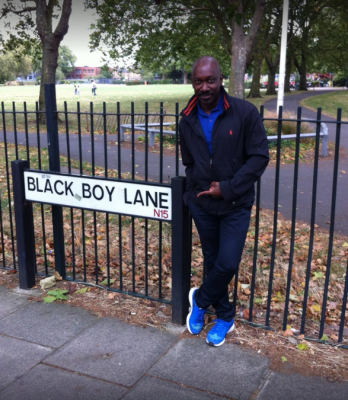

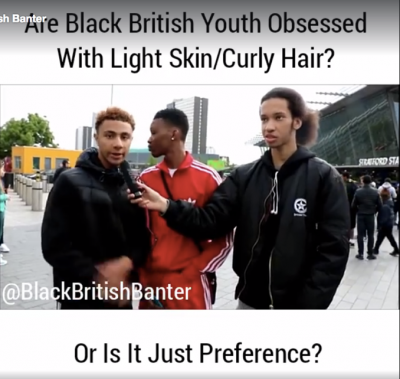
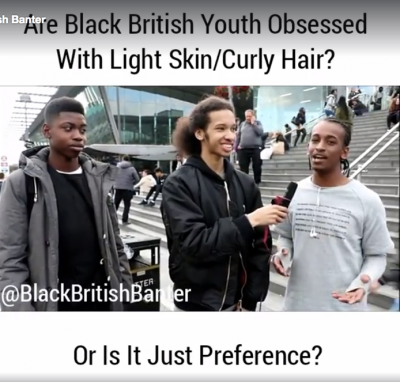
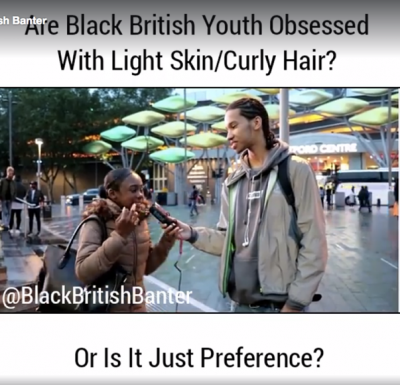
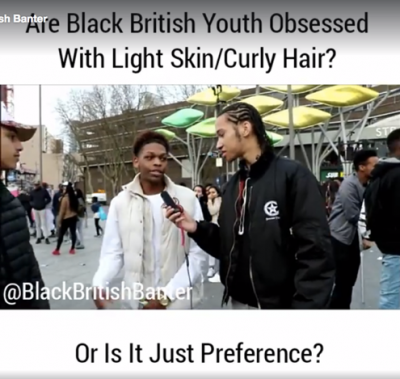
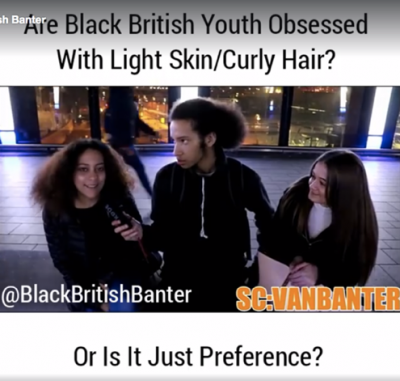
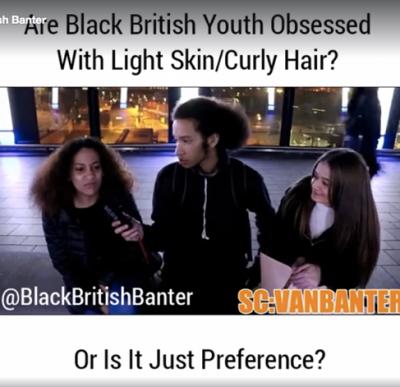
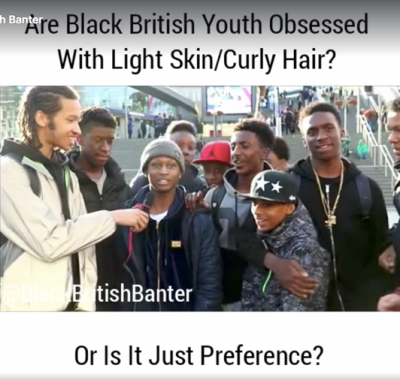
Comments 1
mrstraightblackhair — June 21, 2017
Incredibly insightful.